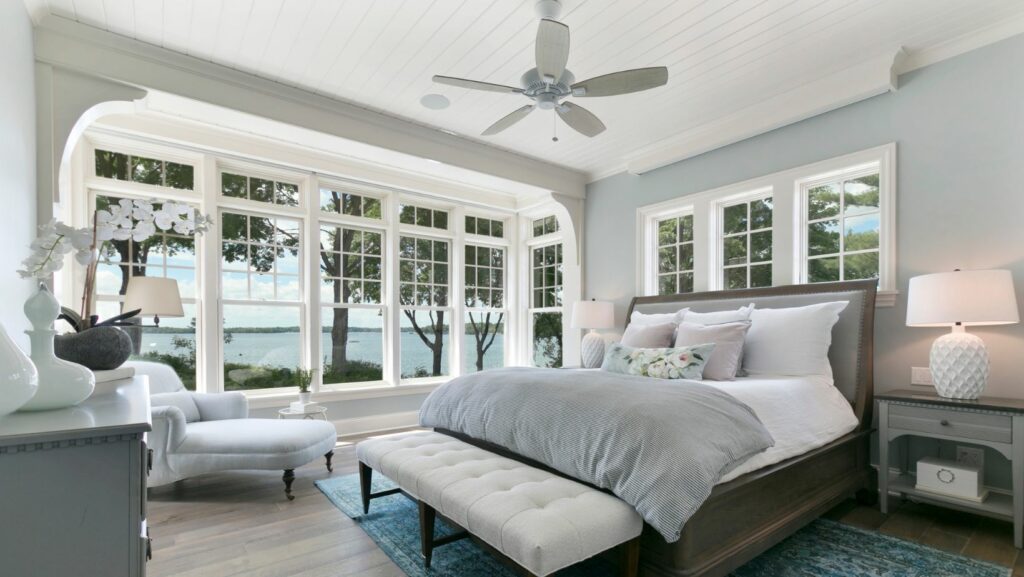Lots of people rely on fans to help them sleep for cooling, white noise, or air circulation. While there are numerous benefits to doing so, there is a downside of sleeping with a fan on at night. Understanding both the pros and cons of using a fan at night can help you make an informed decision about whether it’s the right choice for you.
Pros
1. Temperature Regulation and Cooling Effect
One of the most common reasons people use a fan while sleeping is to regulate room temperature. Fans help circulate air, preventing heat buildup and making it easier to stay cool, especially in warm climates or during hot summer months. By promoting airflow, fans help prevent night sweats and overheating, which can disrupt sleep quality.
2. White Noise for Better Sleep
Fans create a consistent, soothing background noise that can help mask disruptive sounds from the environment. This is particularly beneficial for light sleepers who may be easily disturbed by traffic, noisy neighbors, or household sounds. The white noise effect of a fan can improve sleep continuity by reducing sudden awakenings caused by unexpected noises.
3. Improved Air Circulation and Ventilation
A fan helps keep the air in your bedroom moving, reducing stuffiness and preventing stagnant air. Proper air circulation can minimize the buildup of odors, carbon dioxide, and indoor pollutants, creating a fresher and more comfortable sleep environment. This is especially useful in rooms with poor ventilation or in households where air conditioning is not available.
4. Reduced Humidity Levels
In humid environments, a fan can help reduce the feeling of stickiness by evaporating moisture from the skin. While fans do not actually remove moisture from the air like a dehumidifier, they create an environment that feels cooler and drier, making it easier to sleep comfortably.
5. Energy Efficiency Compared to Air Conditioning
Using a fan instead of an air conditioner can help reduce energy consumption and lower electricity bills. Fans consume significantly less power than air conditioning units, making them a more sustainable and cost-effective option for staying cool at night.
Cons
1. Dryness and Dehydration
One of the biggest drawbacks of sleeping with a fan is that it can dry out your skin, eyes, and nasal passages.

The continuous airflow can cause moisture loss, leading to irritation, dry mouth, and even nasal congestion. People who already suffer from dry skin conditions or respiratory issues may find that sleeping with a fan worsens these symptoms.
2. Potential for Allergies and Respiratory Issues
Fans can circulate dust, pollen, and other allergens in the air, potentially triggering allergy symptoms or asthma attacks. If the fan blades and surrounding areas are not cleaned regularly, they can accumulate dust, mold, and pet dander, which may be blown around the room while the fan is running. This can lead to sneezing, itchy eyes, and congestion.
3. Muscle Stiffness and Body Aches
Prolonged exposure to cool air while sleeping can cause muscles to tighten, potentially leading to stiffness, cramps, or body aches. This is particularly common if the fan is positioned too close to your body or directed at a specific area, such as your neck or shoulders. People who suffer from arthritis or muscle pain may experience discomfort when exposed to constant airflow throughout the night.
4. Noise Sensitivity and Sleep Disruptions
While some people find the sound of a fan soothing, others may find it distracting or disruptive to their sleep. If the fan is too loud, has an inconsistent humming sound, or develops a rattling noise over time, it can become a sleep disturbance rather than a sleep aid. Individuals who prefer complete silence when sleeping may struggle to rest with a fan running in the background.
5. Risk of Temperature Drops and Overcooling
Although fans help keep the body cool, excessive cooling can be a problem, particularly in cooler seasons or for individuals who are sensitive to temperature fluctuations. If the fan is left on all night without adjusting its intensity, body temperature may drop too much, leading to chills or discomfort.
Tips for Sleeping With a Fan
If you prefer to sleep with a fan but want to minimize the potential downsides, consider the following tips:

- Use an oscillating fan rather than a stationary one to distribute air more evenly and avoid prolonged exposure to direct airflow.
- Keep the fan clean by wiping down blades and vents regularly to prevent the spread of dust and allergens.
- Adjust the fan speed to avoid overcooling or excessive air movement that could cause dryness or muscle stiffness.
- Position the fan strategically so that it does not blow directly on your body but still provides sufficient air circulation.
- Use a humidifier in combination with a fan if you experience dryness or nasal congestion.
- Choose a fan with noise control features if you are sensitive to sound and prefer a quieter sleep environment.
Sleeping with a fan has advantages and disadvantages, depending on individual preferences and sensitivities. While it offers cooling benefits, white noise, and better air circulation, it can also contribute to dryness, allergies, and discomfort for some sleepers. By making small adjustments—such as choosing the right fan, positioning it properly, and maintaining humidity levels—you can maximize the benefits while minimizing potential drawbacks. Ultimately, whether or not to sleep with a fan comes down to personal comfort and health considerations.



